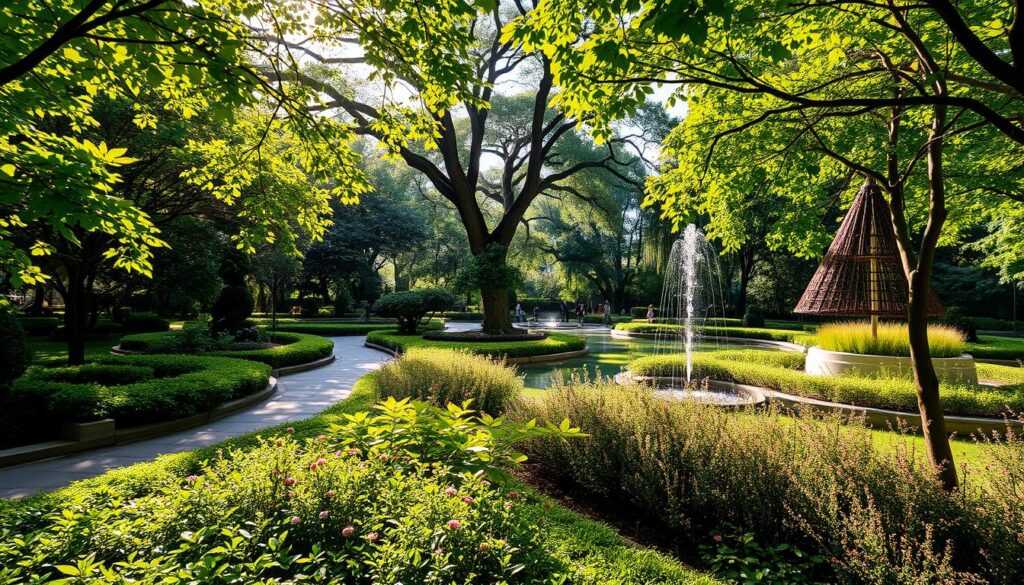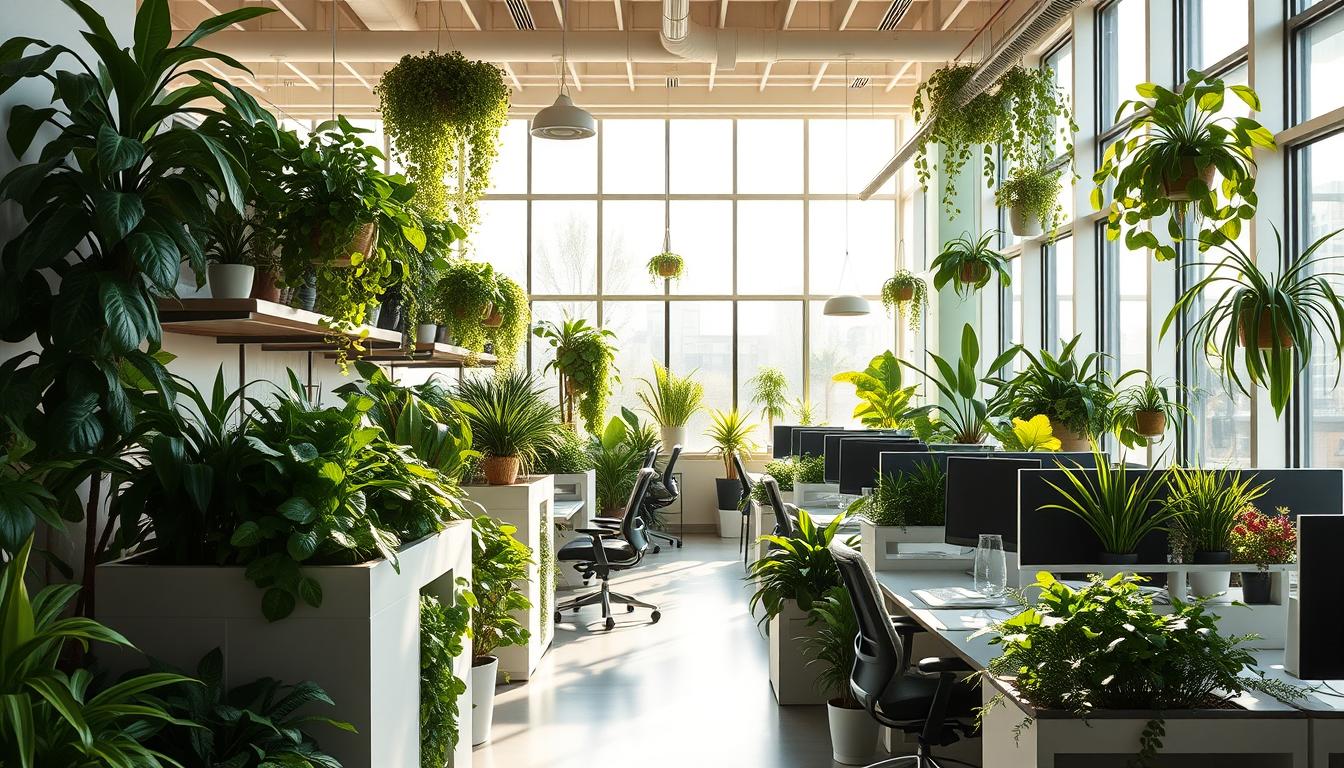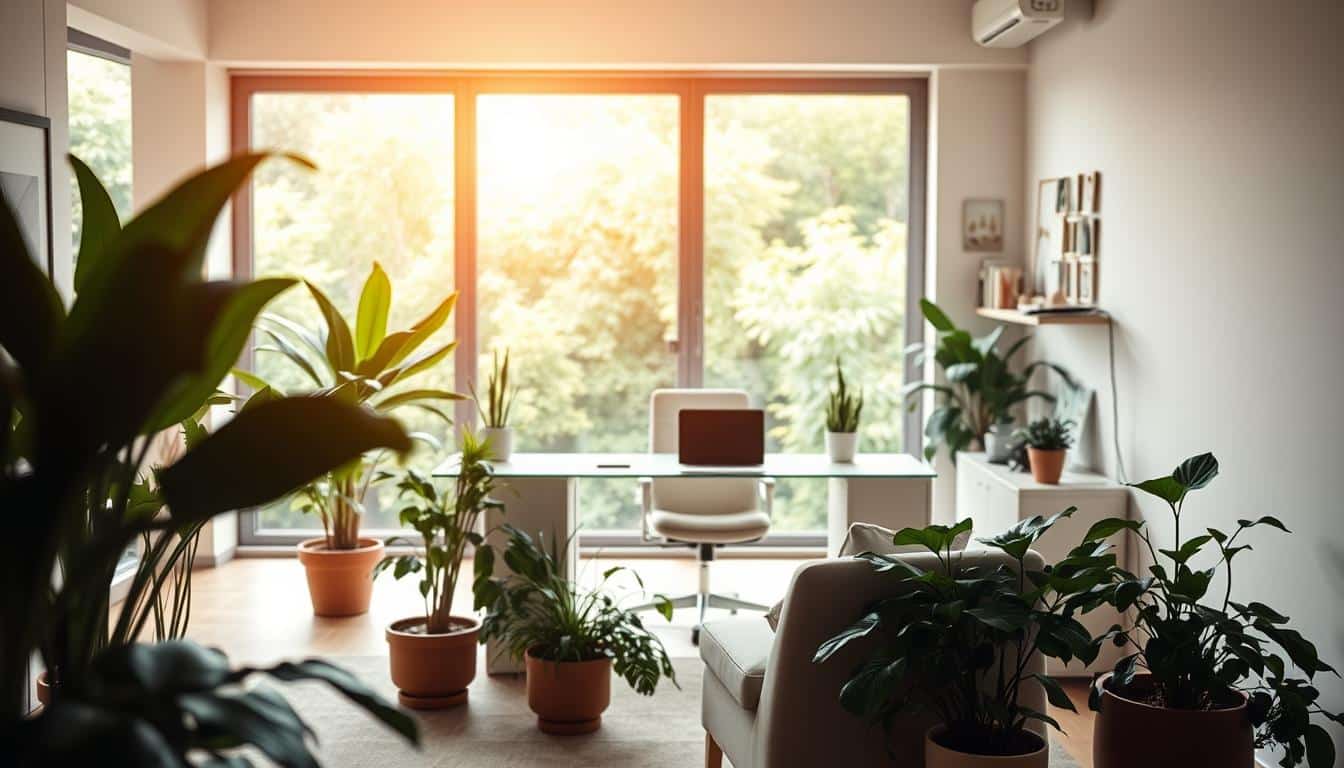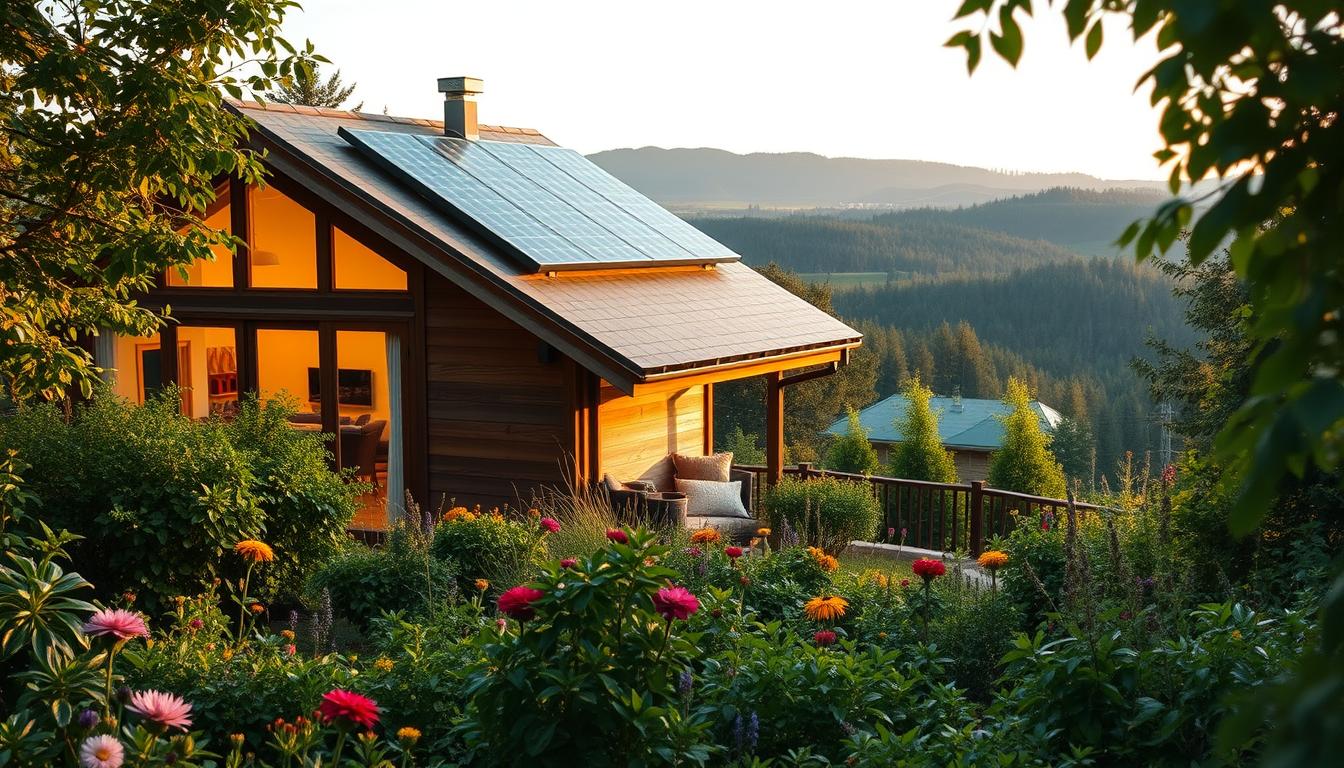In modern cities, adding plants and green spaces is key. This method helps mix city life with nature. It makes cities sustainable while improving life quality for people. Living in a city becomes easier with more greenery around.
Understanding Foliage in Urban Design
Adding green spaces to city design is key for improving the environment. These areas offer beauty and greatly benefit people’s health. With cities getting more packed, using nature is vital for sustainable city planning.
Importance of Green Spaces
Urban areas benefit a lot from green spaces like parks and tree-filled streets. They are important because they:
- Improve air quality by cleaning pollutants and adding oxygen.
- Help cool down cities, fighting the heat island effect.
- Boost biodiversity by providing homes for various plants and animals.
Benefits of Integrating Nature into Cities
Green spaces in cities lead to healthier lives. People who live near nature move more and get fitter. Studies show that being around greenery lowers stress and helps people relax. Plus, shared green spots can bring communities together, making neighborhoods more lively.

Historical Context of Foliage-Based Strategies
Foliage in urban planning has changed a lot through time, influenced by culture, the environment, and money. We learn from history to shape modern landscape designs. Today, how we mix development and nature shows the journey of urban green spaces.
Evolution of Urban Green Spaces
Urban green spaces have evolved from simple parks to complex areas that help both nature and people. In the past, cities were designed with clean lines and symmetry. However, as cities grew, green areas became key for health. Now, we see the importance of blending cities with nature.
Three Distinct Periods in Urban Planning
Urban planning’s history with foliage can be seen in three key times:
- Pre-19th Century: This time loved geometric designs, making parks that looked nice but were mostly for show.
- Industrialization Era: As cities got bigger, there was a push to add green spaces for fun and health.
- Modern Era: Today, there is a push for green areas to be a part of city life, seeing their eco benefits.
Foliage-Based Spatial Organization Strategies
Urban planning strategies are now including more green spaces in busy areas. This is a great way to show how plants can improve city scenes. All around the world, cities are finding creative ways to use greenery. They aim to be both eco-friendly and enrich local communities.
Examples of Effective Implementation
Many cities have led the way with impressive green projects. Here are a few standout examples:
- The High Line in New York City – This elevated park uses various plants and trees. It turns an old railway into a lively green space.
- Millennium Park in Chicago – This park mixes nature and city life with vast green lawns and interesting landscapes.
- Singapore’s Gardens by the Bay – This project is a fantastic mix of technology and plants. It includes vertical gardens and eco-friendly areas.
Balancing Urban Development with Green Areas
Even though building cities is important, maintaining a balance with green spaces is crucial. Zoning laws are key to this balance. These laws help make sure cities include enough green spaces. This can reduce the negatives of urban growth.
Getting the community involved is also important. When local people take part, it helps understand what they need. It also makes them feel more connected to their public spaces.
Impact on Community Well-Being
Adding green spaces in cities improves how people feel and connect. These areas offer many green spaces benefits, like better health and more friendliness among folks. We look at how greenery helps people come together and feel better.
Mental and Physical Health Benefits
Being around nature helps reduce stress and boosts mental health. Studies show that green areas lower anxiety and make people happier. This can help everyone handle tough times better.
It’s also good for our bodies. People living near greenery get sick less often and move more. This means they are healthier overall.
- Greenery helps decrease stress hormones.
- Visiting parks makes you more active.
- Nature helps with healing and getting better faster.
Promoting Social Interactions through Green Spaces
Parks and gardens are key for social interactions, making communities stronger. These places are where folks meet and bond, creating closer neighborhoods. This makes everyone feel more supported and part of a group.
Urban planners can make a big difference by focusing on green areas. This leads to healthier, closer communities.
Challenges of Implementing Foliage-Based Strategies
Making cities greener comes with its set of troubles that need careful thought and planning. Cities often don’t have enough room for more trees and plants. This is because they are built up and crowded. People living there might also resist changes. They fear it might change the look and feel of their neighborhood. Finding smart ways to overcome these problems is crucial.
Urban Density and Space Limitations
City life means dealing with not having enough land for parks and green spots. Even though green spaces are beneficial, they are often left out. This happens because buildings and homes take up most of the space. Trying to add more greenery among tall buildings and busy streets is tough. City planners need to be creative to fit nature into small spaces.
Resistance from Local Communities
When it comes to adding more green to cities, not everyone is on board. Some folks worry about losing important places or the city’s history. But, by getting the community involved and showing them the good sides of having more green spaces, minds can be changed. It’s about building trust and working together. This way, adding trees and gardens can be done without issues.
Key Principles of Foliage-Based Urban Planning
Effective foliage-based urban planning is built on key principles. These principles direct developers and planners towards sustainability. They mix ecological, social, and economic factors into urban design. This approach makes cities both functional and beautiful, focusing on what communities need.
Integrative Approaches to Design
Integrative design blends natural elements with the built environment. It boosts biodiversity and balances ecology, making cities stronger against environmental stress. Planners work with architects and ecologists to enrich cities with plants. Their goal is to design sustainably with everyone’s input, improving the plan’s impact.
Creating Accessible Green Spaces
Accessible green spaces are key in urban planning. They must be open to everyone, improving health and bringing communities together. It’s important to design these spaces for everyone, with different ways to enter and enjoy them. Adding paths, benches, and learning spots invites people to connect with nature and each other. This shows how vital green spaces are in cities.
Case Studies of Successful Foliage Integration
Looking at case studies, we see how big cities have brought plants into their urban spaces. They’ve added greenery in smart ways. This not only looks good but makes city life better. Cities like Singapore and New York are great examples of this success.
A Closer Look at Major Cities
Singapore is known for its green roofs and wall gardens. They’ve changed its cityscape and helped wildlife. These green spots cool buildings and help with rainwater, making Singapore ready for climate issues.
New York City has lots of parks, including Central Park and the High Line. These areas offer fun and make the air cleaner. They show the good that comes from blending nature and city life.
Innovative Solutions in Urban Greenery
- Green roofs on tall buildings boost energy savings and lower city heat.
- Urban forests in cities like Toronto and Melbourne improve the environment and offer homes to wildlife.
- Community gardens boost local food and bring neighbors together.
These examples prove that plant-focused plans can make cities better and more eco-friendly. By adopting such smart ideas, big cities lead the way to a greener tomorrow.
Future Trends in Foliage-Based Spatial Organization
Urban areas are growing fast. There’s a big push for eco-friendly planning in future cities. Having green goals makes cities look better and life better for people living there.
Shifts Towards Sustainability in Urban Planning
Today, cities must have green spots like parks and green roofs. These spaces are good for nature and make our air cleaner. They show how cities are changing to fight climate change and aim for a green future.
Technological Integration in Green Spaces
Technology makes it easier to take care of urban green spots. Smart watering systems save water, and planning tools help choose where to plant trees. These tech solutions keep green areas thriving and help cities face environmental shifts.
Role of Community Engagement in Green Spaces
Community involvement is key in creating and upkeeping green spaces. It makes sure these areas suit what locals want, making them feel connected. When people join in the planning, they use and enjoy these green spots more.
Importance of Public Involvement
Public input is crucial for great green spaces. Locals share what they want and worry about. This shapes these spaces well. It makes them more useful and welcoming. Such places boost health and help people come together.
Strategies for Effective Community Collaboration
To better plan urban greens, try these steps:
- Organizing workshops to gather feedback and ideas from local residents.
- Hosting public forums where community members can discuss concerns and preferences.
- Utilizing interactive planning exercises to visualize potential designs and gather input.
These methods encourage people to take part. They help everyone feel they own a piece of these spaces. When people get involved, green areas thrive, making neighborhoods brighter and healthier.
Conclusion
Adding plants to city planning is key for better city life. We’ve seen how greenery makes cities look good and helps people feel and live better. The benefits of adding more green spaces in cities will keep growing, as everyone sees their value.
It’s also important to deal with the problems of urban living and people who might not want change. By working together, cities can add more nature to their spaces. This will make urban areas lively, green, and healthy places to live.
Everyone has a role in making cities greener, from city planners to everyday people. By choosing to add more plants to our cities, we’re creating a future where cities are strong and in tune with nature.



